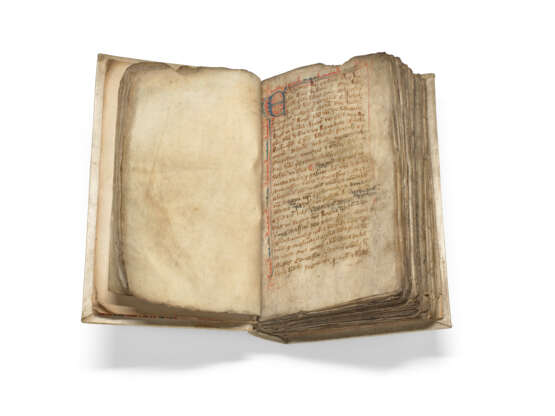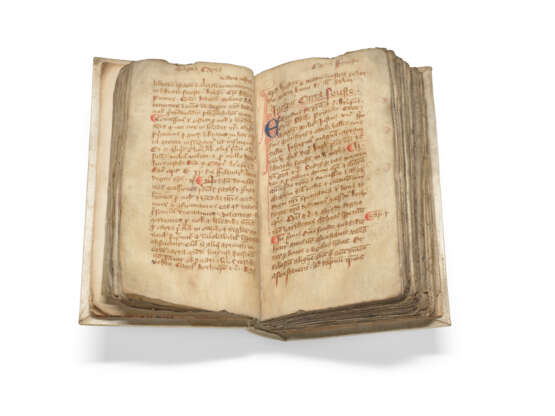ID 1449873
Lot 9 | A portable Magna Carta
Valeur estimée
£ 15 000 – 20 000
Magna Carta and Statutes of the Realm, in Latin and Anglo-Norman French, manuscript on vellum [England, 14th century]
A portable copy of the most renowned and influential legal document of the English-speaking world.
c.151 x 95mm. ii (paper) + 147 + 16 (paper) + ii (paper) leaves, collation: 18, 2-512, 610 (of 12, lacking xi-xii, after ff.66), 7-1112, 1210, 1312, 1416 , the added 15th-century paper gathering c.132 x 90mm, c.22-28 lines, ruled space: 110 x 65mm, large initials in blue with red penwork flourishing extending into the margins, capitals touched in red, paraphs in red, explicits underlined in red, running headers throughout (lacking two leaves after f.66 and a few leaves after f.147, warped, thumbed and soiled, edges somewhat frayed). Bound in 19th-century vellum over pasteboards (boards a little warped).
Provenance:
(1) Arthur Maister (1775-1833) of Kingston upon Hull: his 1815 bookplate inside upper cover. By descent to his son:
(2) ‘J[ohn] Maister’ (1818-1882): his inscription dated c.1846 on second paper flyleaf: ‘An old copy of the Forest Laws… found in the Old House in High Street Hull’.
Content:
Blank f.1; Provisions of Merton ff.2-3; blanks ff.4-8v; Magna Carta, in the 1297 confirmation of Edward I ff.9-16; Charter of the Forest ff.16-20v; Statutes of Marlborough ff.20v-31; Westminster I, in French, ff.31-53; Gloucester, in French, ff.53-59v; ‘Explanation’ of Gloucester ff.59v-60; Westminster II ff.60v-99v; Statute of Fines ff.100-102v; De Religiosis ff.102v-103v; Quo waranto, in French, ff.103v-104; De emptoribus terrarum ff.104v-105; Statutum de Juratoribus et cognitoribus ff.105-106; De moneta ff.106-106v; De wardis et releviis, in French, ff.106v-107; De presentibus vocatis ad warrantum ff.107v-108; Quo waranto ff.108v-110v; De conguerentibus de Ballivis regis, concerning complaints made and to be made of the King’s bailiffs, ff.110v-111; Statutum Rageman, in French, ff.111-112; Sok and Sak ff.112-114; Articuli novi super cartas, in French, ff.114-122; Confirmatio cartarum of 1297, in French, ff.122-124; index of chapters ff.124v-129v; Statutes of Winchester, in French, ff.130-131v; of Merchants, in French ff.131v-135v; of the Exchequer, in French, ff.136-140v; Distresses of the Exchequer, in French, ff.140v-141v; Dies communes in banco ff.141v-142; Dies communes in placito dotis ff.142-142v; Modus calumpniandi essoniam ff.142v-143v; Statutum de regia prohibitione ff.143v-144v; De bigamis ff.144v-145v; De vigiliis ff.145v-147v; Statutes of Westminster, edited during the 27th year of the reign of Henry VI (1449), written in a 15th-century hand on an added gathering of 16 paper leaves, ff.148-149v; blanks ff.150-163v.
By agreeing to the terms of the Charter at Runnymede on 15 June 1215 King John bound himself and all subsequent rulers of his kingdom to the rule of law. In a modified form Magna Carta was reissued in the name of his son and successor, Henry III, in 1216 and 1217, and in 1225 the King once again confirmed the Charter and the accompanying Forest Charter, and this fourth issue was final and definitive: it became a permanent legislative enactment guaranteeing the rights and liberties of all freemen of the kingdom. It already had totemic status – and its name – but not until Edward I’s 1297 confirmation was Magna Carta officially enrolled by Chancery and copied into the first Statute Roll.
Thanks to the interpretation of Sir Edward Coke (1552-1634), Attorney General to Elizabeth I and Chief Justice of James I of England, the Charter had widespread and continuing influence. His interpretation when he cited it against the power of Charles I of England – ‘Magna Charta is such a fellow that he will have no sovereign’ – came to inspire the charters for the American colonies. Coke had himself drafted the first charter for the Virginia Company. The colonies in turn used it to justify revolution against British policies, with the Massachusetts Assembly invoking Magna Carta in declaring the 1765 Stamp Act null and void, and on the eve of revolution adopting a new seal showing a militia man with a sword in one hand and Magna Carta in the other.
The present manuscript is an early example of the collections of enrolled Statutes that began to be produced by the beginning of the 14th century. They were made for use by lawyers and administrators and were often small in size for ease of portability and consultation.
| Lieu d'origine: | Angleterre, Europe du Nord, Europe, Royaume-Uni |
|---|---|
| Catégorie maison de vente aux enchères: | Manuscrits médiévaux et de la Renaissance, Livres et manuscrits |
| Lieu d'origine: | Angleterre, Europe du Nord, Europe, Royaume-Uni |
|---|---|
| Catégorie maison de vente aux enchères: | Manuscrits médiévaux et de la Renaissance, Livres et manuscrits |
| Adresse de l'enchère |
CHRISTIE'S 8 King Street, St. James's SW1Y 6QT London Royaume-Uni | |
|---|---|---|
| Aperçu |
| |
| Téléphone | +44 (0)20 7839 9060 | |
| Commission | see on Website | |
| Conditions d'utilisation | Conditions d'utilisation |






